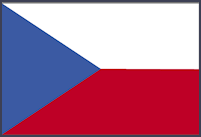Czech Republic - Military Personnel
 After 140 years of conscription service system being exercised in the historical Czech lands, the country abandoned this practice. From the beginning of 2005 it has been building a career soldier system. It is part of a fundamental reform of the Czech military that was launched in 2002 which also involved downsizing, organisational changes, modernisation of equipment and reshaping the locations of garrisons and sites within the republic. In 2006, the military achieved initial operational capabilities and stabilisation of forces. The full operational capabilities are set to be reached before the end of 2014.
After 140 years of conscription service system being exercised in the historical Czech lands, the country abandoned this practice. From the beginning of 2005 it has been building a career soldier system. It is part of a fundamental reform of the Czech military that was launched in 2002 which also involved downsizing, organisational changes, modernisation of equipment and reshaping the locations of garrisons and sites within the republic. In 2006, the military achieved initial operational capabilities and stabilisation of forces. The full operational capabilities are set to be reached before the end of 2014.
According to the 2007 document Transformation of the Czech Ministry of Defence Sector, the total number of personnel planned for the end of 2010 was supposed to be 36,800 (26,200 soldiers, 8,800 civilian employees, and 1,800 trainees). In reality, as of 1 January 2011, the MoD sector recorded 21,309 soldiers, 8,011 civilians and 937 trainees). The reason why the target cannot be achieved lies in insuffi cient budget allocations. In the future, this factor will also be reinforced by other negative trends such as demographics.
The original deadline for the armed forcesí overall of its 26,000 soldiers in order to achieve full operational capability was set for 2012. However, in the wake of defense budget cuts, this was pushed back to 2015. But even this date was not firm. Fundamental modernization projects will most likely not be affected, but there wonít be enough financial resources to execute lower level modernization aims, such as a small caliber arms upgrade and the construction of new military bases. Over the next 15 years, the Czech Army will need to spend hundreds of millions of dollars on tactical equipment for all levels, small caliber machine guns, small terrain vehicles and the reconstruction and upgrade of military IT infrastructure and communication and information systems.
The Czech population is ageing and the MoDís competitive capabilities in the labor market are weakening. Thus, as a consequence of these trends, the armed forces will encounter more diffi culties in recruiting new candidates for military service, and the quantitative ambitions of 26,200 personnel will become unattainable.
The number of people in the age category that is most suitable for recruitment for the armed forces (18 to 25 years of age) will diminish over time. At the same time, those who entered the military in the 1990s will terminate their active service. Hence, it is going to be a challenge to keep a positive balance between growth and attrition and to prevent the armed forces from ageing.
In the interest of stopping or at least slowing down the process of ageing of the armed forces, as well as raising the attractiveness of the military profession and competitive strength in the labour market, the 2011 White Paper proposed the introduction of a new career code which must be based on enforceable rules for a centrally controlled, transparent, competitive and selective professional career, and apply objective criteria for evaluating soldiersí performance. It also proposed an improved interconnectedness of a career path with the personnel system of individual development. Change the content of educational and training programmes. Emphasize the development of practical military skills and command ability of graduates from military schools and career courses.
The White Paper called for enhancing the attractiveness of the military profession. Important factors in this area include: levels of compensation, service pension, compensation for service in locations as required by the armed forces, support to families of soldiers deployed on foreign operations and missions, refurbishing the infrastructure in military garrisons, improving working conditions, medical care of military veterans and pensioners, comprehensive psychological service and military chaplaincy. It also called for rationalizing structures and functions of current training and educational activities and institutes.


|
NEWSLETTER
|
| Join the GlobalSecurity.org mailing list |
|
|
|

